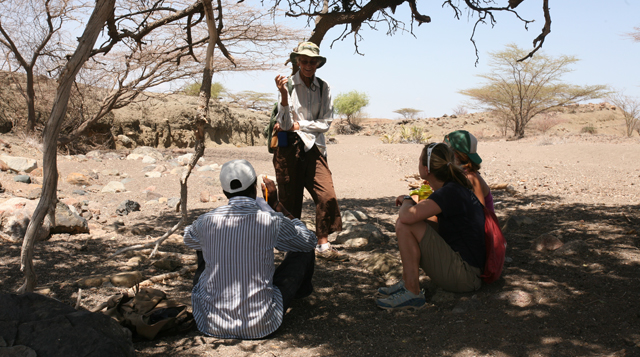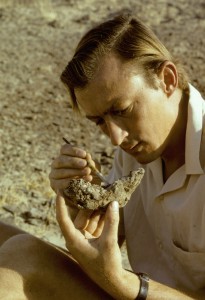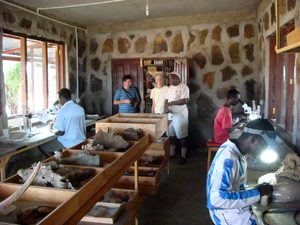A Research Institute in the Cradle of Humanity

In 1967, the fledgling paleoanthropologist Richard Leakey was flying to the Omo River in Kenya when storms diverted his plane to the east side of Lake Turkana, the largest desert lake in Africa. The region had been largely ignored by paleontologists, because it was believed to consist chiefly of volcanic rock not suitable for fossil hunting. Looking down at the lakeshore, Leakey saw extensive stretches of what seemed like sedimentary rocks. Perhaps, he speculated, the area might be a treasure trove of fossils after all.
The years that followed proved him right, as Leakey, his wife, Meave, his daughter, Louise, and other scientists uncovered a wealth of human fossils in the Lake Turkana region.
The lake basin, with its constant sedimentation and frequent seismic rifting that exposes new layers of sediment, contains an almost continuous fossil record from the age of the dinosaurs to the modern era. While some other sites offer a good representation of fossils from relatively short time intervals, “to have this continuous record is pretty unique,” said Lawrence Martin, a paleoprimatologist at Stony Brook University in New York.

In the past four decades, about half of the most important hominid fossils in the world have come from Lake Turkana, Martin said, including the earliest known Australopithecus, Homo erectus and Homo sapiens fossils. More recently, as reported in the August 9 issue of Nature, a team led by Meave Leakey discovered three new fossils that offer the strongest evidence yet that at least two parallel lineages of early humans coexisted with Homo erectus nearly two million years ago.
These discoveries at the lake contributed to a widespread agreement among scientists that all humans today originated from Africa, and to a growing consensus that we descended from a single ancestral population from somewhere near Lake Turkana and spread across the globe 60,000 to 80,000 years ago.
“Now that we know that all humans derive from ancestral populations from this region in the last 100,000 years, we have an extraordinary opportunity to find the fossil remains from our own direct ancestors,” Leakey said.
But the pace of discovery at Lake Turkana has been relatively slow. Searching through the 7,000 square miles of fossil layers exposed at the lake is an enormous task that needs to be repeated regularly as erosion exposes new fossils.
In the decades following Leakey’s initial discovery of the site, scientists wishing to explore Lake Turkana faced formidable logistical challenges. The drive from Nairobi to the east side of Lake Turkana took four or five days, and apart from a few rudimentary stone buildings Leakey’s team had built over the years, no infrastructure awaited researchers setting up camp there. Each expedition lost precious time reinventing the wheel: establishing reliable sources of water and cooking fuel, building a camp and assembling a team of local workers. And all food and equipment had to be driven in from Nairobi.
To address these problems, Leakey founded the Turkana Basin Institute (TBI) in partnership with Stony Brook University, with support from the Simons Foundation.
The new multidisciplinary scientific research institute is building field campuses on both the east and west sides of the lake, since it can take four days to drive from one side to the other. Construction of the west campus, at Turkwel, began in 2008 and was recently completed. This campus offers cottages for up to 24 visiting scientists, dormitories for 30 students, and conference and laboratory facilities with running water, electricity, a cafeteria and wireless Internet.
“When an international team comes for eight weeks,” said Martin, the institute’s director, the goal is to “spend the entire time doing research.”
A similar facility is under construction at Ileret on the eastern shore of the lake, with construction expected to be complete in 2013; meanwhile, the permanent camp there already offers scientists some amenities, such as electricity, water, accommodations and laboratory facilities.

The campus at Turkwel features a large and sophisticated fossil-preparation laboratory with four trained preparators who work year-round so that fossils can be rapidly made available for scientific study and publication. There is a fleet of research vehicles with trained drivers and guides, and rental equipment for field camps. And the institute plans to train Kenyan scientists in fossil excavation and preparation so that the field campuses can be used throughout the year, not just by international scientists visiting for the summer.
While the fossil riches of Lake Turkana were the driving force behind TBI’s creation, scientists from other disciplines are now starting to explore what the region has to offer. Researchers have visited the institute to study botany, alternative energy, fisheries, entomology, linguistics and climatology. Two weather stations, at Turkwel and Ileret, provide modern weather readings that complement the prehistoric global climate information encoded in the rocks of the lake basin.
Martin likens the opportunities at Lake Turkana to those offered by the Antarctic research stations, which were built to study the climate and biology of Antarctica, but which eventually led to new scientific studies and unexpected discoveries, such as the hole in the ozone layer. “We want to provide infrastructure so that people can come, whether they are interested in human migration, water, bugs, or the many other things that can be studied at Lake Turkana,” he said. “There’s an extraordinary range of opportunities, limited only by getting people there and showing them what they can do.”
Stony Brook University, which has extended faculty positions to Louise, Meave and Richard Leakey, operates as TBI’s center of research, hiring, development of facilities and fundraising in the United States. It provides an academic home for graduate students and postdocs working at the institute, as well as facilities for lecture series and conferences and Internet library access for the two campuses at Lake Turkana. TBI also collaborates with the National Museums of Kenya and plans to add new institutional partners in the future.
During the school year, TBI has established a field school, which offers a full semester of undergraduate credits to students who take courses in the ecology and geology of the Turkana Basin, paleontology, human evolution and archaeology. Eventually, the institute expects to host 100 students each year. One-fifth of the program’s spots are reserved for African students, to train the next generation of African scientists.
For the international students in the program, Martin said, the field school offers not just a crash course in the science of Lake Turkana but also the experience of living in one of the most remote parts of the world, whose inhabitants follow a traditional lifestyle. “It’s a life-changing experience for many of the students,” he said.
Developing an institutional presence at the lake has also enabled TBI’s researchers to help protect the lake’s prehistoric treasures. When Tullow Oil recently discovered oil at Lake Turkana, the institute was able to represent the interests of science, sending Kenyan scientists to work in cooperation with the company. “We have people going ahead of the bulldozers, and they have complete authority to stop the bulldozers if there is a site that should be protected,” Martin said. “One of the things we emphasize is that it’s not the heritage of Kenya we’re protecting, but the heritage of humanity.”


